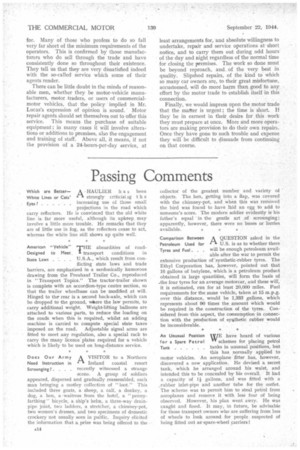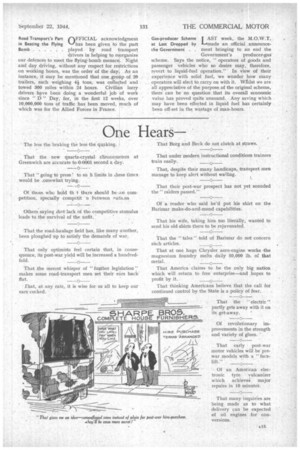Passing Comments
Page 16

Page 17

If you've noticed an error in this article please click here to report it so we can fix it.
A_ HAULIER h a s been strongly criticiziag t h e increasing use of those small projections in the road which carry reflectors. He is convinced that the old white line is far more useful, although its upkeep may involve a little more trouble. He remarks that they are of little use in fog, as the reflectors cease to act, whereas the white line still shows up quite well.
Which are Better— White Lines or Cats' Eyes American " Yehicle" Designed to Meet. State Laws . THE absurdities of road
'. transport conditions in U.S.A., which result from conflicting state laws and trade barriers, are emphasized in a sardonically humorous drawing from the Frenhauf Trailer Co., reproduced in "Transport Topics." The tractor-trailer shown is complete with an accordion-type centre section, so that the trailer wheelbase can be modified at will. Hinged to the rear is a second back-axle, which can be dropped to the ground, witere the law permits, to carry additional weight. Weight-lifting balloons are attached to various parts, to reduce the loading on the roads when this is required, whilst an adding machine is carried to compute special state taxes imposed on the road. Adjustable signal arms are fitted to meet any regulation, also a special rack to carry the many licence' plates required for a vehicle which is likely to be used on long-distance service.
American " Yehicle" Designed to Meet. State Laws .
Does Our Army A VISITOR to a Northern
Need Instruction in Ireland coastal resort Scrounging ? . . . . recently witnessed a strange scene. A group of soldiers appeared, dispersed and gradually reassembled, each man bringing a motley collection of "loot." This included three goats, a sheep, a calf, a donkey, a dog, a hen, a -waitress from the hotel, a " pennyfarthing " bicycle, a ship's helm, a three-way drainpipe joint, two ladders, a stretcher, a chimney-pot, two women's dresses, and two specimens of domestic crockery not usually seen in public. Inquiry elicited the information that a prize was being offered to the.
a14 collector of the greatest number and variety of objects. The hen, getting into a flap, was covered with the chimney-pot, and when this was removed the bird was found to have bid an egg to add to someone's score. The modern soldier evidently is his father's equal in the gentle art _of scrounging; apparently, however, there were no buses or lorries available.
Comparison Between A QUESTION asked in the Petroleum Used for r-1 U.S. is as to whether there
Tyres and Fuel. . will be enough petroleum avail able after the war to permit the extensive production of synthetic-rubber tyres. The Ethyl Corporation has, however, pointed out that 16 gallons of butylene, which is a petroleum product obtained in large quantities, will form the basis of -the four tyres for an average motorcar, and these will, it is estimated, run for at least 20,000 miles. Fuel requirements for the same vehicle, taken at 15 m.p.g. over this distance, would be 1,333 gallons, which represents about 90 times the, amount which would be required in the construction of the tyres. Considered from thisaspect, the consumption in connection with the production of sytathetic rubber would be inconsiderable.
An Unusual Position WE have heard of various for a Spare Petrol " schemes for placing petrol
Tank tanks in unusual positions, but
this has normally applied to motor vehicles. An aeroplane fitter has, however, discovered a new application. He devised a secret tank, which he arranged around his waist, and intended this to be concealed by his overall. It had a capacity of 11 gallons. and was fitted with a .rubber inlet-pipe and another tube for the outlet. The scheme was to permit him to steal petrol from aeroplanes and remove it with less fear of being observed. However, his plan went awry. He was caught and fined. It may, in future, be advisable for those transport owners who are suffering from loss of wheels to look around for people suspected of being fitted out aS spare-wheel carriers ! OFFICIAL acknowledgment has been given to the part played by road transport drivers in helping to r rganize our defences to meet the flying-bomb menac . Night and day driving, without any respect for re trictions on working hours, was the order of the day As an instance, it may be mentioned that one,gro p, of 20 trailers, each weighing 41 tons, was collected and towed 300 miles within 24 hours. Civilian lorry drivers have been doing a wonderful job of work since " D" Day, for, in the first 12 weeks, over 10,000,000 tons of traffic has been moved, much of which was for the Allied Forces in France.
Road Transport's Part in Beating the Flying Bomb
Gas-producer Scheme 1 AST week, the M.O.W.T. at Last Dropped by 1-amade an official announcethe Government . . meat bringing to an end the
Government's producer-gas scheme. Says the notice, " operators of goods and passenger vehicles who so desire may, therefore, revert to liquid-fuel operation." In view of their experience with solid fuel, we wonder how many operators will elect to carry on with it. Wfiilst we are all appreciative of the purpose of the original scheme, there can be no question that its overall economic value has proved quite unsound. Any saving which may have been effected in liquid fuel has certainly been off-set in the wastage of man-hours.




















































